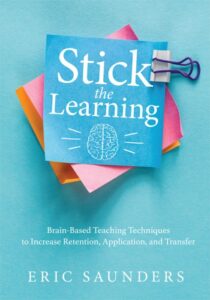Teaching for Retention, Application and Transfer
Stick the Learning: Brain-Based Teaching Techniques to Increase Retention, Application, and Transfer
By Eric Saunders
(Solution Tree Press, 2023 – Learn more)
Reviewed by Megan Balduf

I often share with students how the brain’s systems work and how they can try to manage its reactions. However, this never changed my instructional practice. Teaching kids about their limbic system never transferred to changes in how I created lessons or when I taught content.

Saunders shares the ways teachers should craft curricular experiences, supports his ideas with research, and scaffolds the implementation. This book is going to improve the way you plan your lessons and units so students effectively learn, and retain, your content.
From the outset, Saunders acknowledges education has not kept pace with cognitive science. Science has made great strides in understanding how the brain learns and how people can better retain information. Yet these understandings rarely make a dent in classroom structure or instructional design. In fact, common teaching methods are often antithetical to how brains learn best!
Spaced repetition, interleaving, and retrieval
That’s where Saunders’ SIR technique – spaced repetition, interleaving, retrieval – comes in. It blends the cognitive science of learning with common-sense classroom techniques designed to help students better learn and retain information.
In reading Saunders’s tips, I often felt a sense of deja vu. I could see in his descriptions the ways I learn things and how I’ve seen my children learn. But it was disheartening to realize, too, that I rarely use these techniques when I teach.
In each chapter Saunders shares the research that supports his techniques. One of the strengths of Saunders’ work is that each element is backed by multiple studies. For example, in the chapter about interleaving, there are studies that show both the short-term and long-term impacts of it. Having multiple studies around various aspects of each SIR technique strengthens Saunders’s argument in favor of using them. But he doesn’t stop there.
After providing the data for why the technique works, Saunders shows how it can be used in the classroom, providing examples of what the technique might look like. For spaced repetition, Saunders offers a sample calendar showing how it can be used to teach about six different topics over a two-week timeframe. With interleaving Saunders gives examples of what a test with interleaved questions might look like.
From templates to a quick-start guide
One of my favorite book elements are the templates at the end of each chapter. The book also includes a one-page set of big ideas, so Saunders’s work can be shared – and understood – by those who haven’t read the full text.
After reading Saunders’s text, I’m hoping to convince my PLN to implement some of his SIR techniques. Saunders’ summarization covers the text’s concepts better and more effectively than I ever could, which I hope will lead to more buy-in for these instructional changes.
After quickly and clearly laying out each element of the SIR process, Saunders even gives teachers a quick-start guide to implementing the whole thing. Between the guide and his Frequently Asked Questions, the author does all he can to eliminate any confusion, making the SIR technique as user-friendly as possible and ensuring brain-based instructional methods make it into more classrooms.
Stick the Learning will not only change the way you think about student learning and your instruction, but it will provide you the tools to make immediate changes for the better. No matter when you read this – as you pre-plan during summer, during the winter lull between various holidays and breaks, in the midst of testing season – you’ll be able to take what you learn and alter your instructional delivery as early as the very next day.
Saunders’s book will help you create a classroom environment where students learn more deeply and retain that learning longer. What more can we want for them?
Megan Balduf (@MBalduf) is a middle school English teacher with nineteen years’ experience. Being a classroom teacher was always her dream, and her experience allowed Megan to become a teacher leader, including being part of AMLE’s Teacher Leader Constituent Committee. Since entering the classroom, Megan has earned an MA in Gifted Education and an MA in English for Language Arts Teachers, and has become a National Board Certified Teacher.





































I have been retired for about two decades but I do some tutoring and am unfamiliar with the term interleaving. Could you provide a definition so that I can understand what this technique involves. Thanks.
“Interleaving is a process where students mix, or interleave, multiple subjects or topics while they study in order to improve their learning. Blocked practice, on the other hand, involves studying one topic very thoroughly before moving to another topic.” From UA Learning Initiative (University of Arizona). The webpage offers interweaving strategies. Susan Curtis, MiddleWeb
Thank you so much! Looking forward to reading this!